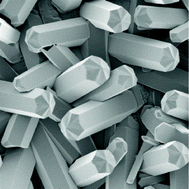One-dimensional ZnO micro/nanostructures: deep insight into the growth mechanism and fine control of the microscopic morphology†
Abstract
One-dimensional zinc oxide arrays with various finely controlled microscopic morphologies are grown on fluorine-doped tin oxide substrates by a hydrothermal method. The relationship between the microscopic morphologies and the reaction conditions are studied deeply. It is found that although all the studied reaction parameters, like reaction time, pH value, concentration of the reactants and so on, can affect the microstructures of the resultant products, what they affect, in essence, is the concentration of free Zn2+ ions of the solution. By exploring the evolution of the microstructure of the one-dimensional zinc oxide crystals, it is proved that the formation of the various microscopic morphologies is a result of the competition between the kinetic control and the thermodynamic control during the crystal growth, which in turn is mainly determined by the concentration of the free Zn2+ ions in the solution. The in-depth exploration of the growth mechanism of zinc oxide and the fine control of its microscopic morphologies is expected to provide advanced materials for current and future cutting-edge applications of zinc oxide. It is also expected that the growth mechanism reported here can provide theoretical support for achieving other oxide materials whose microstructure can be finely controlled.



 Please wait while we load your content...
Please wait while we load your content...